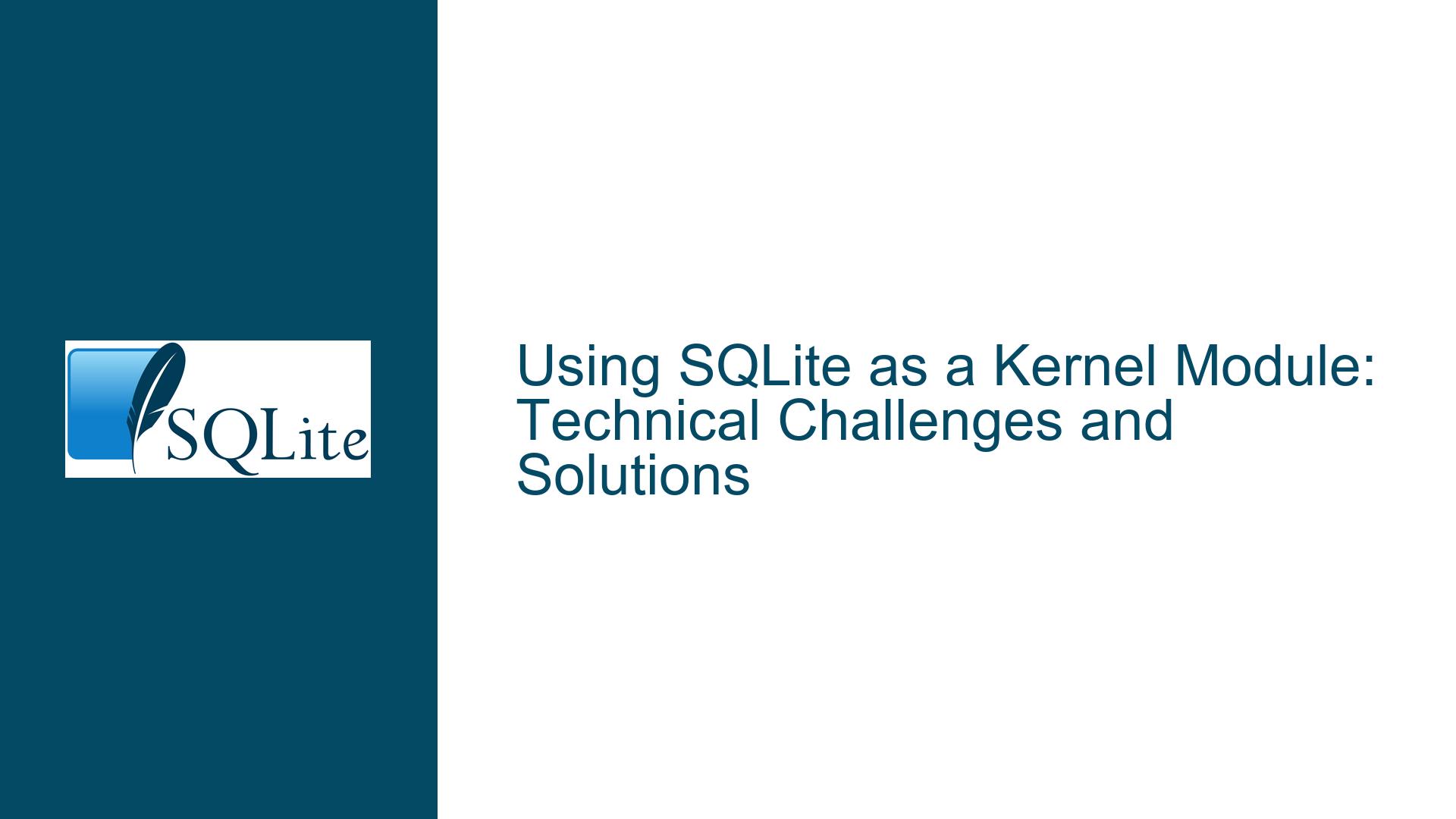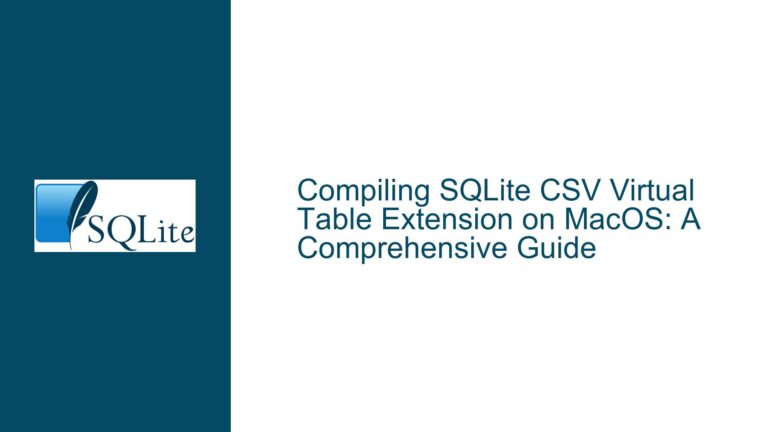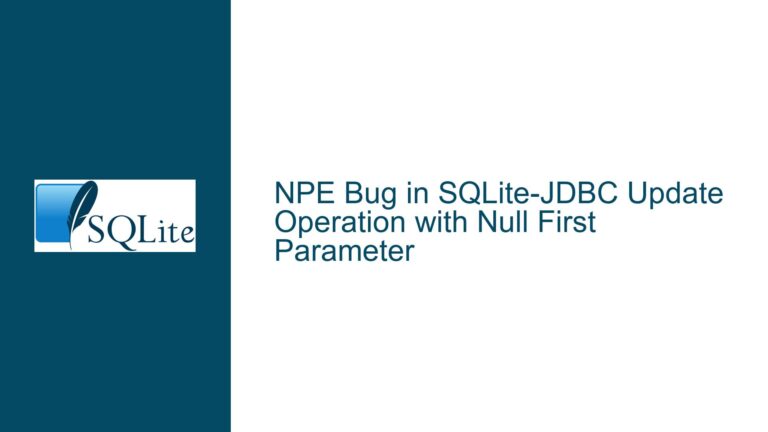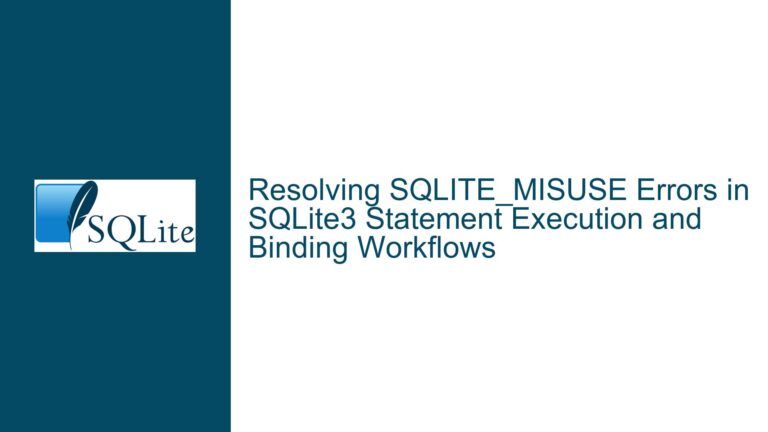Using SQLite as a Kernel Module: Technical Challenges and Solutions
Integrating SQLite into Kernel-Space Environments
The concept of embedding SQLite as a kernel module involves adapting a user-space database library to operate within the constraints and paradigms of kernel-space execution. SQLite’s design inherently assumes it will run in user space, where it has unrestricted access to standard C libraries, system calls, and memory management APIs. Kernel modules, however, operate in a privileged environment with severe restrictions on memory allocation, I/O operations, and thread synchronization.
A kernel module SQLite implementation would require reimplementing or bypassing dependencies on user-space abstractions like file descriptors, heap memory managers (e.g., malloc/free), and POSIX-compliant threading. For example, SQLite relies on the pread() and pwrite() system calls for atomic file operations, which are unavailable in kernel-space contexts. Instead, kernel modules interact with block devices or virtual filesystems through entirely different interfaces, such as the Linux kernel’s struct file_operations.
The absence of a standard C library in kernel space further complicates porting efforts. Functions like printf(), fopen(), and even basic string operations (strcpy, strlen) are either unavailable or require substitution with kernel-specific equivalents (e.g., printk for logging, kstrdup for string duplication). SQLite’s reliance on these functions means that every component of the database engine—from parsing SQL statements to managing transaction logs—must be audited and modified for kernel compatibility.
Another critical consideration is concurrency. User-space SQLite leverages process isolation and thread synchronization primitives like mutexes and semaphores. In kernel modules, concurrency is managed through spinlocks, atomic counters, and interrupt disabling, which demand low-latency, non-blocking designs. SQLite’s default locking mechanisms (e.g., file locks for write-ahead logging) may conflict with kernel-level synchronization strategies, risking deadlocks or race conditions.
Technical and Architectural Barriers in Kernel-Mode SQLite Adoption
Dependency on Unavailable System Calls
SQLite’s architecture assumes the availability of system calls for file I/O, memory mapping, and process synchronization. For instance, the mmap() system call is used to map database files into memory for faster access. Kernel modules cannot invoke mmap() directly; they must instead interact with the kernel’s memory management subsystem through functions like vmalloc() or kmap(). These alternatives lack the same semantics, forcing developers to reimplement memory-mapped I/O from scratch.
Divergent Memory Management Models
User-space applications rely on the heap for dynamic memory allocation, while kernel modules use slab allocators, kmalloc(), and dedicated pools for fixed-size objects. SQLite’s memory allocator is tightly coupled with user-space expectations, such as the ability to allocate arbitrarily sized memory blocks and handle out-of-memory errors via ENOMEM. In kernel space, memory allocation failures often result in panics or undefined behavior, requiring invasive changes to SQLite’s error-handling logic.
Filesystem Abstraction Mismatch
SQLite interacts with filesystems through the VFS (Virtual File System) layer, which abstracts platform-specific file operations. However, kernel modules do not have access to user-space filesystem paths. Instead, they interact with inodes, dentries, and block devices. Porting SQLite’s VFS to kernel space would necessitate creating a shim layer that translates SQLite’s file operations into kernel-friendly equivalents, such as directly manipulating struct file objects or using the bio layer for block-level I/O.
Interrupt Context and Reentrancy
Kernel modules often execute in interrupt context, where operations cannot block or sleep. SQLite’s transaction logic, however, may involve blocking operations like waiting for locks or writing to slow storage. Adapting SQLite to be fully reentrant and non-blocking in interrupt context would require replacing all blocking calls with asynchronous equivalents, a task that conflicts with SQLite’s synchronous design philosophy.
Lack of Standard Debugging Tools
Debugging a kernel module is significantly more challenging than debugging user-space code. Tools like gdb have limited utility, and memory corruption bugs often manifest as catastrophic system crashes. SQLite’s extensive use of dynamic memory and complex data structures amplifies this risk, making it difficult to diagnose issues like buffer overflows or use-after-free errors.
Mitigating Risks and Optimizing SQLite for Kernel-Mode Execution
Rewriting System Call Dependencies
Replace SQLite’s reliance on system calls with kernel-specific APIs. For example:
- Substitute
pread()/pwrite()withkernel_read()/kernel_write(), which operate onstruct filepointers. - Replace
mmap()with a custom memory-mapped I/O layer usingvmalloc_user()andremap_pfn_range()to map kernel memory into user space if necessary. - Implement a kernel-compatible file locking mechanism using
flockfile()alternatives or atomic bit operations on shared memory regions.
Custom Memory Allocator for Kernel Space
Develop a slab allocator tailored to SQLite’s memory usage patterns. SQLite allows custom allocators via sqlite3_config(SQLITE_CONFIG_MALLOC, ...). A kernel-mode allocator could:
- Use
kmem_cache_create()for frequently allocated objects (e.g.,sqlite3_stmt,Btreestructures). - Reserve emergency memory pools to avoid allocation failures during critical operations.
- Integrate with the kernel’s memory pressure notification system to proactively release non-essential caches.
Kernel VFS Shim Layer
Create a lightweight VFS implementation that bridges SQLite’s file operations to kernel APIs. This shim would:
- Translate SQLite’s
xOpen()method tofilp_open()for acquiringstruct filehandles. - Map
xRead()/xWrite()tokernel_read()/kernel_write(), ensuring proper handling of file offsets. - Implement
xLock()using kernel-internal locking primitives likestruct mutexorstruct rw_semaphore.
Non-Blocking Concurrency Model
Refactor SQLite’s locking subsystem to avoid blocking in interrupt context:
- Replace mutexes with spinlocks (
spin_lock_irqsave()) for short-duration critical sections. - Use atomic operations (
atomic_t) for reference counting and journal status flags. - Defer long-running operations (e.g., checkpointing) to kernel worker threads via
kthread_run().
Static Configuration and Minimized Footprint
Disable non-essential SQLite features to reduce attack surface and memory usage:
- Compile SQLite with
-DSQLITE_OMIT_PROGRESS_CALLBACK,-DSQLITE_OMIT_LOAD_EXTENSION, and-DSQLITE_OMIT_SHARED_CACHE. - Preallocate fixed-size memory pools using
SQLITE_CONFIG_PAGECACHEto avoid dynamic allocation during transactions. - Link against a stripped-down libc replacement like
klibcto provide minimal standard function implementations.
Robust Error Handling and Recovery
Harden SQLite against kernel-specific failure modes:
- Replace
assert()with kernel’sBUG_ON()for fatal errors, ensuring stack traces are logged. - Implement automatic transaction rollback on task termination to prevent database corruption.
- Use the kernel’s watchdog timer (
CONFIG_WATCHDOG) to detect and recover from deadlocks.
Testing and Validation Strategies
- Leverage kernel sanitizers like KASAN (Kernel Address Sanitizer) to detect memory errors.
- Use virtualization platforms (QEMU) for safe, iterative testing of the SQLite kernel module.
- Integrate with the kernel’s
ftraceframework to profile query execution times and lock contention.
Community and Commercial Solutions
- Explore forks like SQLite4 (unmaintained) or proprietary variants designed for embedded kernels.
- Adopt a hybrid architecture where a user-space SQLite process communicates with the kernel via
netlinkor shared memory, avoiding direct kernel integration.
By systematically addressing these challenges, developers can achieve a functional SQLite integration within kernel modules, albeit with significant trade-offs in maintainability and performance.






